Chain saws are relatively common and may seem simple to operate. But felling trees and clearing brush with a chain saw are operations that require training and proper safety precautions. Logging is among the most dangerous professions. And if it is dangerous for professionals, it is even more so for the average landowner. So, carefully consider the need for training before buying and using a chain saw. MU Extension publication G1954, Selecting and Maintaining a Chain Saw, highlights safety features to look for when purchasing a chain saw. It also contains some helpful tips for maintaining a saw. MU Extension publication G1958, Felling, Limbing and Bucking Trees, provides basic information for cutting down trees.
Prepare yourself
Prepare yourself for operating a chain saw. Read the operator’s manual and obtain training from someone who is experienced with chain saws. It is very important to become familiar with the recommended safe operational procedures before attempting to work with a chain saw. Although you could learn how to use a chain saw from experience alone, that may come at a very high price — mishap and injury — and probably isn’t worth it.
Be sure that you are in top physical and mental condition when operating dangerous machinery. Medicines, alcohol and similar influencing factors can cause you to be a hazard to yourself and others when working with a chain saw. Your chances of injury are much lower when you are alert, well-rested and healthy.
Obtain the following personal protective equipment (PPE) before starting to work, and wear it when sawing (Figure 1):
- Hard hat to protect your head from falling limbs or branches. The best helmets also have a face guard.
- Safety glasses or goggles (if your helmet does not have a face guard) to prevent eye injury from flying wood chips.
- Ear muffs or ear plugs to protect ears from permanent injury. Noise from some gas-powered chain saws can exceed 100 decibels. A hard hat that includes ear muffs and a face shield is the best PPE for chain saw work.
- Lightweight gloves, preferably leather, to protect hands from abrasions and cuts.
- Trim-fitting clothing free of ragged edges. Loose clothing will readily snag on limbs or get caught in the saw.
- Chain saw chaps to protect your legs from saw kickback. These chaps are made of ballistic nylon fibers that, when cut, clog the chain saw and stop it from cutting.
- Work boots with high tops and steel toes to protect your feet.
Know basic first aid, especially for severe bleeding, second-degree burns and shock. Knowing what to do in the event of a saw kickback resulting in a deep cut, an unprotected hand coming in contact with a hot muffler, or the victim going into shock could mean the difference between life and death, particularly if you are working in a remote location. Also, make sure all individuals know the location of the first-aid kit and that the kit contains plenty of sterile, absorbent gauze pads.
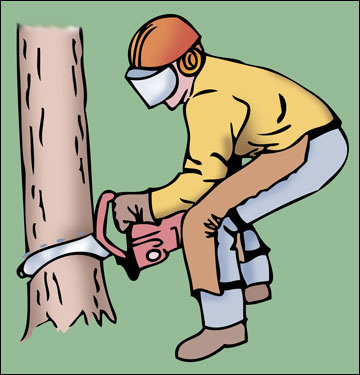
Prepare the saw
Preventive maintenance always pays off with chain saws. Properly sharpened teeth will cut quickly, smoothly and more safely. Be sure to wear gloves or cover the chain with a heavy rag when sharpening the saw teeth. The newly sharpened teeth will easily inflict injury. File or grind according to instructions for best performance.
A clean air filter, good spark plug and effective muffler will ensure a better running engine, making your work easier and safer. Follow the manufacturer’s advice in the operator’s manual when adjusting the engine or chain.
Proper chain tension helps ensure long chain life and safer cutting. A chain that is too loose tends to derail and whip about dangerously; a chain that is too tight will bind and wear prematurely. All chains stretch with use and need frequent checking and readjustment.
Good lubrication helps to prolong chain life and maintain tension adjustment. Check the oil often and refill according to instructions. Be sure to use the correct bar oil.
Starting and operating techniques
Before starting the engine, set the saw on firm ground in an open area free of any obstacles or combustible materials, such as a fuel can or leaves. Make sure the chain brake is engaged (check the owner’s manual for how to engage the brake). If the chain brake is not engaged, when the engine starts the engine speed may be fast enough for the clutch to engage the sprocket and turn the chain. If the bar touches any object, it may cause the saw to kick back toward you.

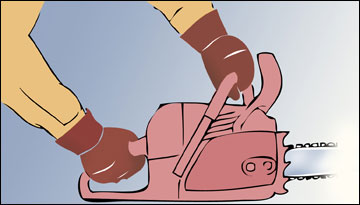
Maintain good balance and secure footing. Grip the front handlebar of the saw firmly with your left hand and press down. For saws with a C-shaped rear handle, put the toe of your right foot into the rear handle and press down (Figure 2). With your right hand, pull out the starter grip until you feel a definite resistance and then give it a brisk, strong pull.
During operation, always hold the chain saw firmly with both hands. Wrap your fingers and thumbs around the handles (Figure 3). Grip the front handle with your left hand and the rear handle with your right hand, even if you are left-handed. With your hands in this position, you can best oppose and absorb the push, pull and kickback forces of the saw without losing control.
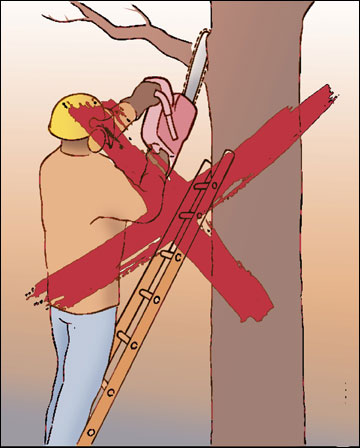
Keep proper footing and balance at all times. Take special care in slippery conditions, such as wet ground or snow, and in difficult, overgrown terrain. Watch for hidden obstacles such as tree stumps, roots, rocks, holes and ditches to avoid stumbling. Be extremely cautious when working on slopes or uneven ground. Never use the chain saw with one hand. Using one hand makes it more difficult for you to control reactive force and to prevent the bar and chain from skating or bouncing along the limb or log. See Figure 4 and the list of chain saw don'ts for more safety tips.
Reactive forces: Kickback, pushback, pull-in
The powerful force used to cut wood can be reversed and work against you. If the rotating chain is suddenly stopped by contact with a solid object, such as a log or branch, or is pinched, a reactive force may occur instantly. The reactive force may result in loss of control, which, in turn, may cause a serious or fatal injury. The most common reactive forces are kickback, pushback and pull-in.
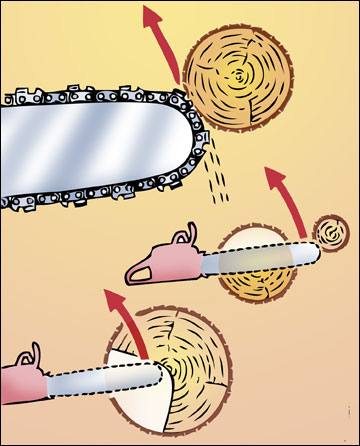
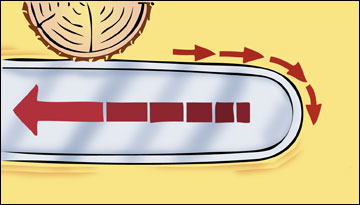
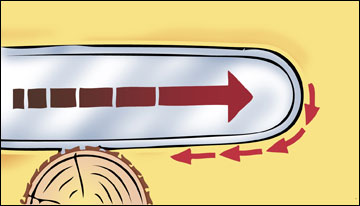
Kickback may occur when the moving saw chain near the upper quadrant of the bar nose contacts a solid object or is pinched in the log or branch (Figure 5). The reaction of the cutting force causes a rotational force on the chain saw in the direction opposite to the chain movement. This may fling the bar up and back in a lightning-fast reaction in an uncontrolled arc toward you. Even though your saw should be equipped with a safety chain that reduces the risk of kickback, the chain does not eliminate the hazard. The best protection from personal injury that may result from kickback is to follow these safe practices:
- Hold the saw firmly with both hands.
- Always be aware of the location of the guide bar nose.
- Never let the nose of the guide bar contact any object.
- Do not cut limbs with the nose of the guide bar.
- Do not overreach.
- Do not cut above shoulder height.
- Begin cutting and continue at full throttle.
- Cut only one log at a time.
- Use extreme caution when reentering a previous cut.
- Do not attempt to plunge cut if you are not experienced with these cutting techniques.
- Be alert for shifting of the log or other forces that may cause the cut to close and pinch the chain.
- Stand to the side of the cutting path of the chain saw.
- Properly maintain the saw chain.
Pushback occurs when the chain on the top of the bar is suddenly stopped when it is pinched or caught or encounters a foreign object in the wood (Figure 6). The reaction of the chain may drive the saw rapidly straight back toward you and may cause you to lose control of the saw. Pushback frequently occurs when the top of the bar is used for cutting. To avoid pushback, follow these safe practices:
- Be alert to forces or situations that may cause the log or branch to pinch the top of the chain.
- Do not cut more than one log at a time.
- Do not twist the saw when withdrawing the bar from an undercut because the chain can pinch.
Pull-in occurs when the chain on the bottom of the bar is suddenly stopped when it is pinched or caught or encounters a foreign object (Figure 7). The reaction of the chain pulls the saw forward and may cause you to lose control of it. Pull-in frequently occurs when the bumper spike of the saw is not held securely against the tree or limb and when the chain is not rotating at full speed before it contacts the wood. To avoid pull-in, follow this safe practice:
- Always start a cut with the chain rotating at full speed and the bumper spike in contact with the wood.
Fueling the saw
Follow good fire safety practices when refueling a chain saw. Refuel the saw in an open area after it has cooled, at least 10 feet away from where you wish to restart the saw and resume cutting. Fuel the saw at least 20 feet away from fires and lighted cigarettes. Use proper funnels and spouts to prevent spills. Wipe the saw dry of any spilled fuel before starting it.
Saw transport and storage
For transport, set the saw level with the fuel tank cap up. Be sure the saw cannot tip over and spill fuel or oil. Avoid carrying the saw in the passenger area of a vehicle. Use a chain guard or a carrying case to protect yourself as well as the chain.
For long-term storage, drain the fuel tank in a safe, well-ventilated area. Run the saw at idle until it stops to remove the remaining fuel from the tank. Remove the chain, and store it in a container of oil. Disconnect the spark plug wire to reduce the possibility of accidental starting. Store the saw out of the reach of children